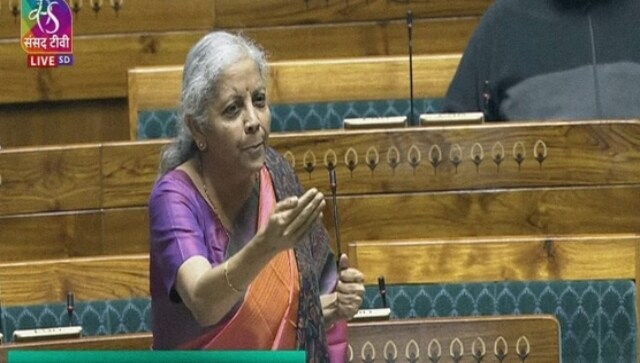10 years of Modi govt: NDA 'White Paper' lists how it rescued economy from 'UPA-inflicted' crisis
10 years of Modi govt: NDA 'White Paper' lists how it rescued economy from 'UPA-inflicted' crisis

Finance Minister Nirmala Sitharaman on Thursday tabled a ‘White Paper’ on the Indian Economy’ in the Lok Sabha.
Sitharaman in her Interim Budget speech had announced that the government will come out with a ‘White paper’ on the economy outlining the economic mismanagement in the 10 years of UPA rule till 2014.
The NDA government has overcome the crisis of those years, and the economy has been put firmly on a high sustainable growth path with all-round development, Sitharaman said.
“It is now appropriate to look at where we were then till 2014 and where we are now, only for the purpose of drawing lessons from the mismanagement of those years. The Government will lay a White Paper on table of the House,” she had said.
When the Modi-led NDA government assumed office, the economy was on a road to nowhere, exhibiting tell-tale signs of deep distress emanating from multiple ‘wrong turns’ in
economic policy.
Here’s how NDA rescued the economy from state of crisis, despair and paralysis:
- As soon as the government took over in 2014, it recognised the urgent need to revamp
and overhaul systems and processes, to help India advance on the path of development
while also bolstering its macroeconomic foundations. - Right from spearheading the digital revolution to elimination of open defecation, and
from successfully vaccinating the entire eligible population using indigenous vaccines to substantially diversifying exports, India achieved remarkable milestones under our new governance paradigm. - The govt constituted an expenditure Reform commission to rationalise and prioritise government expenditures to achieve desired development outcomes and make effective use of tax payers’ money for nation building.
- The government continued to undertake measures to unearth black money and to discourage recourse to it.
- In parallel, the government also strengthened the health of the economy and the business sector. The foundation for a comprehensive reform process was laid in the initial years of the government.
- The initiation of the reform process started yielding positive results in the early years of
the government, by improving the investor climate and creating a favourable outlook for the economy. The Industrialists who earlier preferred to invest in other countries exhibited a new sense of excitement for investing in India. India was right back on top in their list of countries to invest in. - Over the past decade, this trust in India’s economic potential has strengthened. Both domestic and foreign investors exhibit high optimism regarding India’s growth potential, anticipating abundant opportunities as the economy expands.
- Since the time the government assumed power in 2014, the Indian economy has
undergone many structural reforms that have strengthened the macroeconomic
fundamentals of the economy. - These reforms resulted in the transition of India from the league of ‘Fragile Five’ to the
league of ‘Top Five’ in just about a decade as the economy was transformed into a far
more resilient avatar amid a challenging global environment. - In the past ten years, the government has revitalised the stagnant financial sector and
overhauled the credit ecosystem within the economy, bringing about significant
improvements. - The government’s vision of “Nation First” has transformed the quality of India’s
infrastructure and logistics ecosystem, which will be key for the country to attract
investments and expand its presence in global value chains. For instance, when the government took charge in FY15, the pace of national highway construction languished at 12 km/day. The pace of construction rose more than 2.3X to 28 km/day in FY23 - In addition, the procurement of critical equipment for the defence sector, paramount for national security was not prioritised by the UPA government. These have been
emphasised by our government. - The reform measures undertaken by our government have significantly elevated the
medium-term investment prospects of the economy. - Empowerment through welfare has been the leitmotif for the NDA government which adopted the philosophy “sabka sath, sabka vikas” prioritising universal access to basic amenities, and a participatory, mission-mode approach in actualising this philosophy.
- The government resolved the execution challenges that plagued the UPA
government by implementing technology-based targeting and monitoring mechanisms - Besides physical and digital efficiency of implementation, this Government also utilised
behavioural change and social capital through “Swachh Bharat”, “Beti Bachao Beti
Padhao”, and a pro-active communication of schemes and programmes. - The government has innovated the delivery infrastructure besides widening the social
security net. - Besides substantially improving upon the UPA government’s programme delivery, the
government also undertook several policy innovations to tap India’s development
potential. - The PM-Kisan Samman Nidhi empowered farmers and improved their incomes without
hurting the borrower-lender relationship. - To tackle the enduring challenge of high inflation inherited from the UPA government in
2014, our government strategically addressed the root cause of the problem by
implementing responsible fiscal and monetary policies. - The government has made concerted efforts to control the high external sector
vulnerability inherited from the UPA Government. - Due to the economy’s strong fundamentals restored by the government, Rupee
demonstrated resilience during global shocks such as the Russia-Ukraine conflict and
taper tantrum of 2021-22 by major central banks. - Not only did our government manage the current account prudently, but it ensured its
smooth and comfortable funding via more stable foreign direct investment (FDI). - When the government came to office, public finances were not in a healthy state. To
restore public finances to good health, our government went to great lengths to
transform India’s fiscal system into a reformed tax and spending ecosystem. - Moving away from the past practice, below-the-line financing is now being transparently disclosed.
- The market borrowings of the Central Government, which had grown at phenomenal
rates during the UPA years, were controlled by our government. - In absolute numbers, the budgeted capital expenditure has increased over five-folds
from FY14 to FY24 (RE), without any heating-up of the economy. - Contrary to the UPA Government’s approach of expanding the budgets during the high
growth periods (pro-cyclical), the present government has followed a prudent fiscal policy of containing the budget size during peak cycle of GDP growth to generate adequate fiscal space for handling any unforeseen events. - The introduction of the GST regime was a much-needed structural reform.
- Far-reaching tax reforms over-past decade have put in place effective systems that have
improved revenue collection and compliances. - Acknowledging that States are equal partners in development, our government, in the
true spirit of cooperative federalism, accepted the recommendations of the 14th and 15th Finance Commission. - In order to address the inefficiencies and enhance the competition and transparency in
the coal sector, multiple reforms were taken up by our government in the last ten years. - The government has addressed the multiple issues plaguing the power sector of the
country, thus transforming it from power-deficient to power-sufficient. - Since 2014, our government has taken several steps to correct the situation in the
telecom market and to effectively handle the failures that resulted from the lack of
clarity in policy in the sector.





















